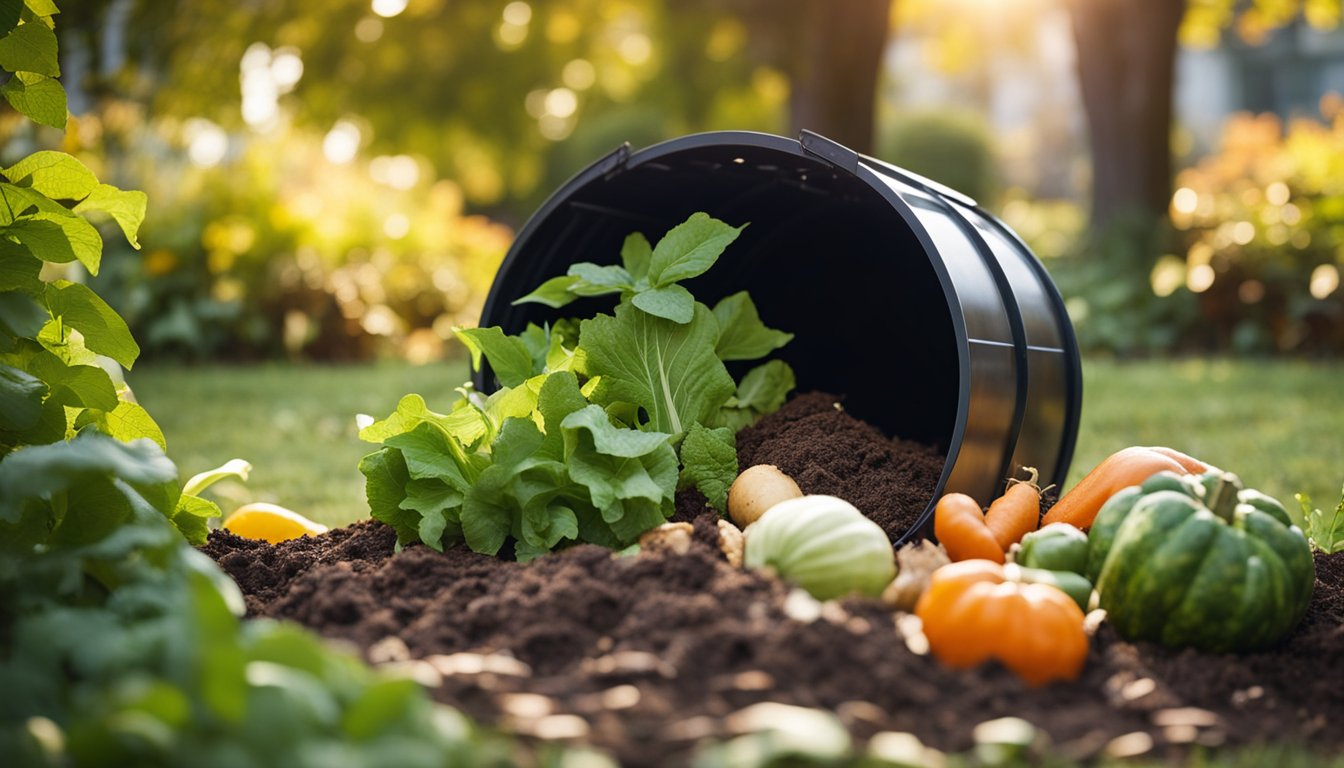Have you ever thought about turning your kitchen scraps and yard waste into rich, nourishing soil? Making a compost pile is not just a rewarding project; it’s a simple way to reduce waste and create an eco-friendly garden. I’ve discovered that composting transforms everyday organic materials into black gold for my plants, and it’s easier than you might think.
Imagine feeding your garden with nutrient-dense compost while minimizing your carbon footprint. With just a few basic steps, you can start your composting journey today. Whether you have a sprawling backyard or a cozy balcony, there’s a composting method that fits your lifestyle. Let’s dive into the essentials of creating your own compost pile and unlock the secrets to sustainable gardening.
Understanding Composting
Composting transforms organic waste into rich soil. This process recycles materials like food scraps and yard debris.
What Is Composting?
Composting involves breaking down organic matter through natural processes. Microorganisms, insects, and moisture work together to decompose materials. The end result is a nutrient-dense product known as compost. It’s like magic but with worms and bacteria instead of wands.
Benefits of Composting
Composting offers several advantages. It reduces the volume of waste sent to landfills, which helps lower greenhouse gas emissions. Nutrient-rich compost enhances soil health, supports plant growth, and improves moisture retention. It also saves money on fertilizer. Plus, who doesn’t love giving back to the earth? By composting, I contribute to a sustainable cycle, turning garbage into gold for my garden.
Materials Needed for Making a Compost Pile

Creating a compost pile requires specific materials that help break down organic waste efficiently. I’ll walk you through the essentials needed to kick off composting.
Green Materials
Green materials form the nitrogen-rich backbone of your compost. They include:
- Kitchen scraps: Fruit and vegetable peels, coffee grounds, and eggshells.
- Grass clippings: Freshly cut grass provides moisture and nutrients.
- Plant trimmings: Trimmed leaves and small branches boost nitrogen content.
Mixing these materials keeps your compost fresh and enriches it. Too much green? It might smell. Balance is key to happy composting!
Brown Materials
Brown materials add carbon to your compost pile. They help with aeration and moisture retention. Look for these items:
- Dry leaves: Crunchy and plentiful, they work wonders.
- Cardboard: Shredded cardboard pieces keep things airy.
- Wood chips: Small chips from untreated wood provide structure.
Layering brown materials in your compost keeps the process efficient. Just remember, a little goes a long way!
Additional Ingredients
Some extra ingredients can boost your composting game. Consider adding:
- Coffee filters: They add organic matter without extra fuss.
- Manure: If you have access, this natural fertilizer supercharges your pile.
- Worms: Introducing worms fosters a faster breakdown and creates worm castings, the ultimate compost booster.
Steps for Making a Compost Pile

Creating a compost pile is simple and rewarding. I’ll guide you through the essential steps to turn kitchen scraps and yard waste into rich compost.
Choosing the Right Location
Select a spot that’s easily accessible. I prefer a well-drained area, away from direct sunlight,too much sun can dry out the pile. Look for a space with good airflow. A little shade can help balance temperature, ensuring microorganisms thrive. Don’t forget, it’s wise to keep it close to your garden for easy access.
Building the Pile – Making A Compost Pile
Start by layering materials. I usually begin with brown materials like dry leaves or cardboard. This provides much-needed carbon. Next, add green materials like vegetable scraps and grass clippings for nitrogen. Aim for a ratio of about 2 parts brown to 1 part green. Keep mixing it up. Adding a sprinkle of water helps hydrate the pile, making it optimal for decomposition. Don’t forget about worms, they’re like the ninjas of composting, silently working to break down the matter!
Maintaining the Compost Pile
Check your compost regularly. If it smells bad, it might be too wet, just aerate it by turning it with a pitchfork. If it’s too dry, toss in some water or fresh greens. Aim to turn the pile every few weeks to speed up decomposition. You might even find some useful bugs, beneficial insects help too! After a few months, the pile’s transformation will amaze you. It’ll turn into dark, crumbly compost, ready to enrich your garden.
Troubleshooting Common Issues
Sometimes, composting presents challenges. Here are solutions for a few common issues to keep your compost pile healthy and productive.
Odor Problems – Making A Compost Pile
Strong odors often signal that the compost pile lacks balance. Too many green materials can create a smelly environment. To fix this, mix in more brown materials like dry leaves or shredded paper. Aeration also helps. Turning the pile increases airflow, reducing odor. If it starts to smell like rotten eggs, that’s a surefire sign of anaerobic conditions. Just add more carbon materials or turn the pile more frequently. A little extra care goes a long way in keeping those smells at bay.
Pests and Vermin
Pests can sometimes view your compost pile as a buffet. To ward off unwanted critters, avoid adding meat, dairy, and oily food scraps. These attract animals like raccoons and rats. Instead, stick to vegetable scraps and garden waste. It’s safer and smells better, too. Covering the pile with a tarp can also deter pests. This way, you can focus on composting instead of pest control.
Slow Composting
If decomposition takes too long, your pile may lack balance or moisture. Regularly check moisture levels; the compost should feel like a damp sponge. If it’s too dry, sprinkle some water over it. A well-maintained pile heats up during decomposition. If you find it sluggish, turn it more often. This boosts airflow, speeds up the process, and turns your kitchen scraps into his nutrient-rich black gold faster. With a bit of attention, you can speed things up and enjoy your compost reward sooner.
Before You Go – Making A Compost Pile

Starting a compost pile is one of the simplest yet most impactful steps I’ve taken towards sustainable living. Watching kitchen scraps and yard waste transform into rich compost has been incredibly rewarding. By balancing green and brown materials and maintaining the right conditions, I’ve created a thriving ecosystem right in my backyard.
I encourage you to embrace composting and experience the benefits firsthand. It’s not just about reducing waste; it’s about nurturing the earth and enhancing your garden. With a little patience and care, you’ll soon have a valuable resource that supports healthy plants and promotes a greener lifestyle. So grab your materials and start your composting journey today! Don’t forget to add The Herb Prof to your favorites so you don’t miss out on future articles.
References – Making A Compost Pile
Little Herb Encyclopedia, by Jack Ritchason; N.D., Woodland Publishing Incorporated, 1995
The Ultimate Healing System, Course Manual, Copyright 1985, Don Lepore
Planetary Herbology, Michael Tierra, C.A., N.D., Lotus Press, 1988
Handbook of Medicinal Herbs, by James A. Duke, Pub. CRP Second Edition 2007
The Complete Medicinal Herbal, by Penelope Ody, Published by Dorling Kindersley
Check the Following Articles
How to Grow Dill for Your Garden and Kitchen
Maca Root Powder Amazon Review: Benefits and Usage
Why Drink Cloves with Cinnamon First Thing in the Day?
Watermelon Seeds Nutrition: A Hidden Superfood
Frequently Asked Questions – Making A Compost Pile
What are the benefits of composting kitchen scraps and yard waste?
Composting kitchen scraps and yard waste creates nutrient-rich soil, reduces landfill waste, lowers greenhouse gas emissions, and improves soil health. It encourages eco-friendly practices and supports plant growth, ultimately saving money on fertilizers.
How do I start composting at home?
To start composting, choose a well-drained, accessible spot in your yard. Layer brown materials (like dry leaves) and green materials (such as kitchen scraps) in a 2:1 ratio. Maintain the pile by regularly checking moisture levels and turning it every few weeks.
What materials can I compost?
You can compost green materials like fruit and vegetable scraps, grass clippings, and plant trimmings. Brown materials include dry leaves, cardboard, and wood chips. Avoid composting meat, dairy, and oily foods, as they can attract pests.
How do I maintain my compost pile?
To maintain your compost pile, ensure it is moist but not soggy, and keep adding materials in the correct ratio. Turn the pile every few weeks to promote aeration, and monitor for odors or pests to ensure a healthy composting process.
What should I do if my compost pile smells?
If your compost pile smells, check the balance of green and brown materials. Adding more brown materials and increasing aeration by turning the pile can help reduce odors. Ensure you are not adding meat or dairy products to prevent unwanted smells.
How long does it take to make compost?
The time it takes to create compost can vary but generally ranges from 3 to 6 months. Proper maintenance, like regular turning and ensuring the right moisture balance, can speed up the process, leading to dark, crumbly compost within a few months.
Can I compost indoors?
Yes, you can compost indoors using a compost bin or worm bin. Choose a compact system that fits your space and use kitchen scraps like vegetable peels and coffee grounds. Regular maintenance and proper ventilation will help control odors and pests.

